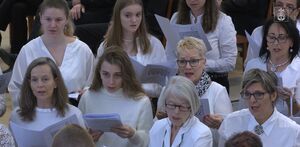When Jesus knocks at the door
“God is in our presence”, is the title of an old hymn. Its original title “Remembering the glorious and sweet presence of God” expresses what people tend to often forget, namely that God is their daily companion.

Gerhard Tersteegen, a well-known church man in his day, made God’s presence a kind of blueprint for his life. The man from the Lower Rhine area was a follower of Lutheran pietism and fought for “true faith” throughout his life. At age 16 he experienced an epiphany, as he later wrote. He freed himself from constraints and being other-directed, lived off charitable gifts and yet remained a benefactor himself. Poor, peaceful, and probably content, he died at the age of 71. Today still the man is fondly remembered.
Vineyards – vines – branches
“The presence of Christ” is the theme of the January services in the New Apostolic congregations. This may be a bit more abstract today than at the time of Tersteegen 300 years ago, so that modern people naturally ask how this can come about today. How can God be present in my life? Interesting is that the answer has actually always remained the same. Important is one’s attitude, one’s knowledge, and the willingness to recognise and know. Helpful in this are examples which Jesus already passed on to His church in His time so that the members would understand. For example, that He, Jesus, is the vine and His church the branches. This is an image that people can understand because vines and branches can be touched. The branches suck their life from the vine stem on which they grow. Delicious fruit grows after a period of ripening.
The only reason the church even exists, is because of its close relationship with Jesus Christ, from whom it receives the spiritual nourishment that enables it to fulfil its tasks. God is the vinedresser in this image, who looks after His vineyard. Jesus compares believers to the branches on a vine: an image that shows wonderful unity, a living organism. The fruit-bearing branches grow from the vine and form a close and vital union with the vine and benefit from the sap that comes from the roots, and is transported through the stem and into the branches. The branches can only bear fruit if they are connected to the stem of the vine.
Where two or three are gathered
Jesus is not only to be present in the individual, but also in the midst of His congregation. In fact, when the congregation gathers for a divine service it can be certain that Jesus Christ is present in word and sacrament, true to the Bible verse: “Where two or three are gathered together in My name, I am there in the midst of them” (Matthew 18: 20). In fact, He is not only in the centre of the congregation, but is its centre. Putting Jesus in the centre is a worthwhile agenda in the new year. He is the centre of the sermon—a high standard for the preacher. He is the focus of our prayers—a mission for anyone who prays. And He is the centre of Holy Communion, which would not even be possible without Him.
Whoever recognises this unique presence of God in the centre of the congregation will be able to participate in His peace, blessing, and help.
Recognising and doing
This is what we need to recognise. No matter how abstract modern times may seem: Jesus Christ is the power and wisdom of God. This is part of the knowledge that modern man must attain. Faith is a gift from God, with which believers receive the wisdom to recognise that the death of Jesus is not a failure, but THE decisive victory in salvation history. For them the gospel, which Paul refers to as the message of the cross, is the source of strength, act of redemption, and at the same time encouragement to profess their belief: “… to those who are called, both Jews and Greeks, Christ the power of God and the wisdom of God” (1 Corinthians 1: 24).
Photo: Vladyslav - stock.adobe.com
















